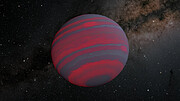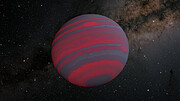Astronomers at Western University have discovered the most rapidly rotating brown dwarfs known. They found three brown dwarfs that each complete a full rotation roughly once every hour. That rate is so extreme that if these “failed stars” rotated any faster, they could come close to tearing themselves apart. Identified by NASA’s Spitzer Space Telescope, the brown dwarfs were then studied by ground-based telescopes including Gemini North, which confirmed their surprisingly speedy rotation.
Three brown dwarfs have been discovered spinning faster than any other found before. Astronomers at Western University in Canada first measured the rotation speeds of these brown dwarfs using NASA’s Spitzer Space Telescope and confirmed them with follow-up observations with the Gemini North telescope on Maunakea in Hawai‘i and the Carnegie Institution for Science’s Magellan Baade telescope in Chile. Gemini North is one of the pair of telescopes that make up the international Gemini Observatory, a Program of NSF’s NOIRLab.
“We seem to have come across a speed limit on the rotation of brown dwarfs,” said Megan Tannock, the Western University physics and astronomy graduate student who led the discovery. “Despite extensive searches, by our own team and others, no brown dwarfs have been found to rotate any faster. In fact, faster spins may lead to a brown dwarf tearing itself apart.”
Brown dwarfs are, simply put, failed stars. They form like stars but are less massive and more like giant planets [1].
Tannock and Western University astronomer Stanimir Metchev worked with international collaborators to find three rapidly rotating brown dwarfs spinning around their axes once every hour. This is approximately 10 times faster than normal [2], and about 30 percent faster than the most rapid rotations previously measured in such objects.
The astronomers used large ground-based telescopes, Gemini North in Hawai‘i and Magellan Baade in Chile, to confirm the rapid rotations. They did this by measuring alterations in the brown dwarfs’ light caused by the Doppler effect and using a computer model to match those alterations to spin rates [3]. The researchers found that these brown dwarfs spin with speeds of about 350,000 kilometers per hour (around 220,000 miles per hour) at their equator, which is 10 times faster than Jupiter.
“These unusual brown dwarfs are spinning at dizzying speeds,” said Sandy Leggett, an astronomer at Gemini North who studies brown dwarfs. “At about 350,000 kilometers per hour, the relatively weak gravity of the brown dwarfs is barely holding them together. This exciting discovery by the Tannock team has identified rotational limits beyond which these objects may not exist.”
The team first identified the rapid rotation rates by using NASA’s Spitzer Space Telescope to measure how quickly the brightness of the objects varied. “Brown dwarfs, like planets with atmospheres, can have large weather storms that affect their visible brightness,” explained Metchev. “The observed brightness variations show how frequently the same storms are seen as the object spins, which reveals the brown dwarf’s spin period.”
The team’s results will appear in an upcoming issue of The Astronomical Journal.
Notes
[1] There are four known giant planets in the Solar System: Jupiter, Saturn, Uranus, and Neptune.
[2] Stars, brown dwarfs, and planets generally spin around their axis once every 10 hours or more slowly. For example, Earth spins around its axis once every 24 hours while Jupiter and Saturn take about 10 hours. The Sun spins around its axis on average every 27 days. The Sun’s rotation rate varies with latitude, with its equatorial regions completing a rotation in about 25 days and the polar regions rotating once in approximately 35 days.
[3] As each brown dwarf rotates, light from the hemisphere turning toward us appears blueshifted while light from the hemisphere turning away from us appears redshifted because of the Doppler effect. This causes absorption lines in the brown dwarf’s spectrum to appear broadened (stretched both toward the red end of the spectrum and the blue end of the spectrum). By matching this broadening to a computer model, the astronomers determined how fast each brown dwarf is spinning.
More Information
This research will be presented in the paper Weather on Other Worlds. V. The Three Most Rapidly Rotating Ultra-Cool Dwarfs, to appear in The Astronomical Journal.
The team is composed of Megan Tannock (Western University), Stanimir Metchev (Western University and American Museum of Natural History), Aren Heinze (University of Hawai‘i), Paulo A. Miles-Páez (European Southern Observatory), Jonathan Gagné (Planétarium Rio Tinto Alcan and Université de Montréal), Adam Burgasser (University of California, San Diego), Mark S. Marley (NASA Ames Research Center), Dániel Apai (University of Arizona), Genaro Suárez (Western University), and Peter Plavchan (George Mason University).
NSF’s NOIRLab (National
Optical-Infrared Astronomy Research Laboratory), the US center for
ground-based optical-infrared astronomy, operates the international Gemini Observatory (a facility of NSF, NRC–Canada, ANID–Chile, MCTIC–Brazil, MINCyT–Argentina, and KASI–Republic of Korea), Kitt Peak National Observatory (KPNO), Cerro Tololo Inter-American Observatory (CTIO), the Community Science and Data Center (CSDC), and Vera C. Rubin Observatory (in cooperation with DOE’s SLAC National Accelerator Laboratory). It is managed by the Association of Universities for Research in Astronomy (AURA) under a cooperative agreement with NSF
and is headquartered in Tucson, Arizona. The astronomical community is
honored to have the opportunity to conduct astronomical research on
Iolkam Du’ag (Kitt Peak) in Arizona, on Maunakea in Hawaiʻi, and on
Cerro Tololo and Cerro Pachón in Chile. We recognize and acknowledge the
very significant cultural role and reverence that these sites have to
the Tohono O'odham Nation, to the Native Hawaiian community, and to the
local communities in Chile, respectively.
Links
Megan Tannock
Western University
Email: mtannock@uwo.ca
Stanimir Metchev
Canada Research Chair in Extrasolar Planets
Institute for Earth and Space Exploration, Western University
Email: smetchev@uwo.ca
Amanda Kocz
Press and Internal Communications Officer
NSF’s NOIRLab
Cell: +1 626 524 5884
Email: amanda.kocz@noirlab.edu



